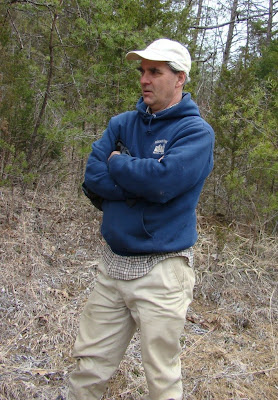Winter is a fabulous time to see the structure of plants, and some unusual adaptations that insects use for wintering. Have you ever seen pine cones growing on willows? Wait a minute, willows don't grow "pine" cones! No but, an insect can cause this look-a-like gall.
 The pine cone gall on willow is not uncommon
The pine cone gall on willow is not uncommon. Deep inside this structure, a little insect has created an inner sanctum. Not unlike the thickened bulbs on the stems of goldenrod, it is the
winter home of a insect- just trying to get by.
Or this- the bag worm. Finding unusual cone-like structures on your arborvitae or blue spruce? Weirder yet, I have seen these "cones" on sycamore trees. So, they can't be a pine cone, right? These structures are created by an insect, which gathers leaf (needle) pieces and web them together for its winter home.
...
We studied some of these in an eye-opening "Diagnostics" class, taught last night by Denise Ellsworth, at Master Gardener training. I tend to look at these problems with a bit of a different perspective though. Instead of wanting to know what to spray them with, or how to kill them, I always wonder... what eats them? Will these larva hatch out when the warblers are migrating? Will they provide food for a family of Phoebes? If you DON'T spray them with poison, what happens next?
Tent caterpillars- the bane of gardeners everywhere. Except me. I have watched a Baltimore Oriole feasting on these fuzz-balls during migration. And cuckoos are adapted to tolerate those stiff-bristled larva; could I deny them a meal?
...
Once you tune into nature, your first reaction ceases to be: reach for the spray! Most of these insects will naturally occur and naturally be held in check in a balanced ecosystem. After all, web worms maybe considered unsightly, but they are unlikely to kill a a tree.
...
Bag worms can defoliate pines and spruce to the point of no-recovery, since they do not regenerate needle like a deciduous tree. So if it is already a goner, why not see which interesting birds come by to feed?
...
Live Curious. It is not just a Nat Geo saying, it is a whole way of life.
 Opulence- a Hoary Redpoll. .... ... ... Steve is an enthusiastic birder/photographer (see photo above) in a small Ohio town, who hit the jack-pot this winter. He has a Hoary Redpoll visiting his feeder. It was a bit of a poser at first, almost unbelievable that this rarity would pick this non-descript residential area to call home. After asking a few experts, Steve went straight to the top- Sibley himself, IDed this little fluff-ball with a crimson cap and a miniature bill. .. ... .
Opulence- a Hoary Redpoll. .... ... ... Steve is an enthusiastic birder/photographer (see photo above) in a small Ohio town, who hit the jack-pot this winter. He has a Hoary Redpoll visiting his feeder. It was a bit of a poser at first, almost unbelievable that this rarity would pick this non-descript residential area to call home. After asking a few experts, Steve went straight to the top- Sibley himself, IDed this little fluff-ball with a crimson cap and a miniature bill. .. ... .  Here is one of my sorry photos, documenting the bird visiting one of the two feeders in the yard. We will never know why it came here- or why now, but I have to believe it is good Karma. ...
Here is one of my sorry photos, documenting the bird visiting one of the two feeders in the yard. We will never know why it came here- or why now, but I have to believe it is good Karma. ... 















































